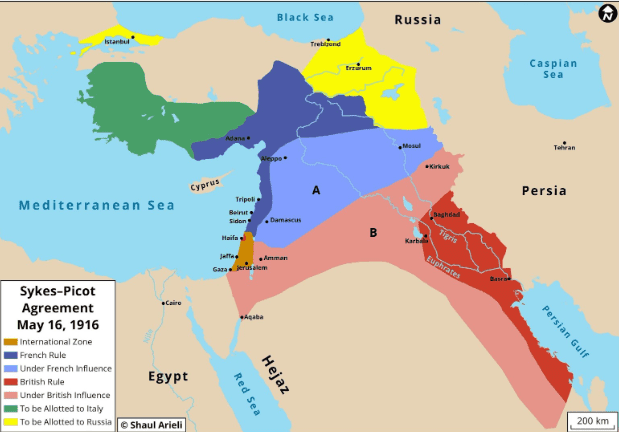By David Davidian
Armenians became collateral damage twice in just over a century when great powers and those with parallel interests used nationalism in achieving their congruent goals. This article is meant to be less of a history lesson than it is to expose the consequences of manipulating nationalism for the benefit of third parties.

During the lead-up to WWI, the British and their supporters, to dismember the Ottoman Empire, needed to supplant (but not remove) Islam as the centripetal force uniting the Empire’s varied Muslim populations and replace each with senses of nationalism. The British plan, albeit one supported by others including Germany, was to create an ethnic glue—one of the strongest forces of nationalism—to supplant Islam.”
This operation was the most ambitious. As a British intelligence officer, TE Lawrence led much of the Arab uprising against the Turks, fulfilling the dreams of the Sykes-Picot Agreement, a secret arrangement between England and France with nods from Russia and Italy for the engineered dismemberment of the Ottoman Empire. The days were numbered for the archaic, despotic, and bureaucratic Ottoman Empire. Twentieth-century republics had their basis as nation-states. Germany’s Bismarck and Italy’s Garibaldi both architected the unification of their states within established borders. Nation-states, unlike kingdoms and empires, need a population with some form of shared identity.
Many internal and external forces contributed to supplanting Islam as the primary identity vehicle for Turkish-speaking Muslims in the Ottoman. The list included Pan-Turkism such as the Hungarian Turkologist Armin Vámbéry. Balkan Turks were exposed to the successes of European republics, including Mustafa Kemal, later known as Mustafa Kemal Ataturk, and even Pan-Turkish writers in Baku. The 1908 Young Turk revolution that deposed the Ottoman Sultan had clear Turkish nationalist overtones. Young Turk ideologues such as Ziya Gokalp and pan-Turkist Munis Tekinalp, envisioned a Turkey for the Turks. Crypto-Jews (see Donme) in positions of influence encouraged a Turkish national identity. Zionists needed such dismemberment as a precondition for the 1917 Balfour Declaration. The 1913 coup d’etat by the proto-fascist wing of the Young Turk party set the stage for eliminating the unassimilable in an envisioned Turkish state. Under the guise of WWI, Armenian civilization was cleansed across Anatolia, followed by the Greek and Assyrian. Eventually, an expression of Kurd identity became an enemy of the Turkish state. As the Empire was being dismantled, much of the Turkish war effort was being expended on deporting Armenians, killing a million and a half of them, looting their property, and escorting Muslim refugees from the Balkans and the Caucasus into former Armenian homes. Young Turks, especially those associated with Mustafa Kemal, were more interested in an eventual Turkish state than the rest of the Empire, already being disassembled by imperial Europe. Many interests did not like the presence of Armenians throughout the region. Exterminating the Armenians was one solution to the Armenian Question.
Today, some forces wish to dismember Iran if it will not unilaterally end its nuclear program and much of its advanced delivery systems. Despite Turkish President Erdogan’s anti-Semitic rants, Turkey is allowed to serve a neo-Ottoman policy that pressures Iran as well as Russia in Central Asia. The West, particularly Israel, actively encouraged and supported Azerbaijan’s capture of the historic Armenian-populated region of Nagorno-Karabakh in 2020. This support was not based on so-called internationally recognized borders (note: Israel’s silent annexation of Syria’s Golan Heights and NATO’s creation of Kosovo violated such tenets) but rather to encourage a sense of an Azerbaijani nationalist success that is hoped to spill over into Azerbaijani-speaking northwest Iran. An increase in Turkish influence in the southern Caucasus that would supplant Russian influence would serve Western interests. What initially might have been a Russian-Turkish quid pro quo, with Turkey increasing its regional influence, instead resulted in a multi-thousand strong Russian contingent having installed itself ostensibly to protect what remains of Nagorno-Karabakh Armenians on land that Azerbaijan considers its territory. It’s not that Israel or Georgia, the latter having offered its airspace to Turkish jets, with ISIS fighters imported into Azerbaijan to fight Armenians, had anti-Armenian policies, but rather both had pro-Azerbaijani policies for different reasons. The Azerbaijani capture of Nagorno-Karabakh and especially lands extending to the Iranian border is hoped, by certain regional powers, to impress upon Iranian Azerbaijan (called southern Azerbaijan by Baku) to consider demands for union with the Republic of Azerbaijan. The immediate goal is to add to Iran’s internal social and political pressure. The loss of Iranian Azerbaijan would dismantle Iran, as the British and others accomplish with the Ottoman Empire.
Over four thousand Armenian young men, and civilians, lost their lives fighting Azerbaijan’s 2020 Nagorno-Karabakh War, run by the Turkish General Staff. Unrestrained Turkish nationalism created a century ago is continuing to be used today generating more collateral damage.
Yerevan, Armenia
Author: David Davidian (Lecturer at the American University of Armenia. He has spent over a decade in technical intelligence analysis at major high technology firms. He resides in Yerevan, Armenia).
(The views and opinions expressed in this article are only of the authors and do not necessarily reflect the views, opinion or position of World Geostrategic Insights).








